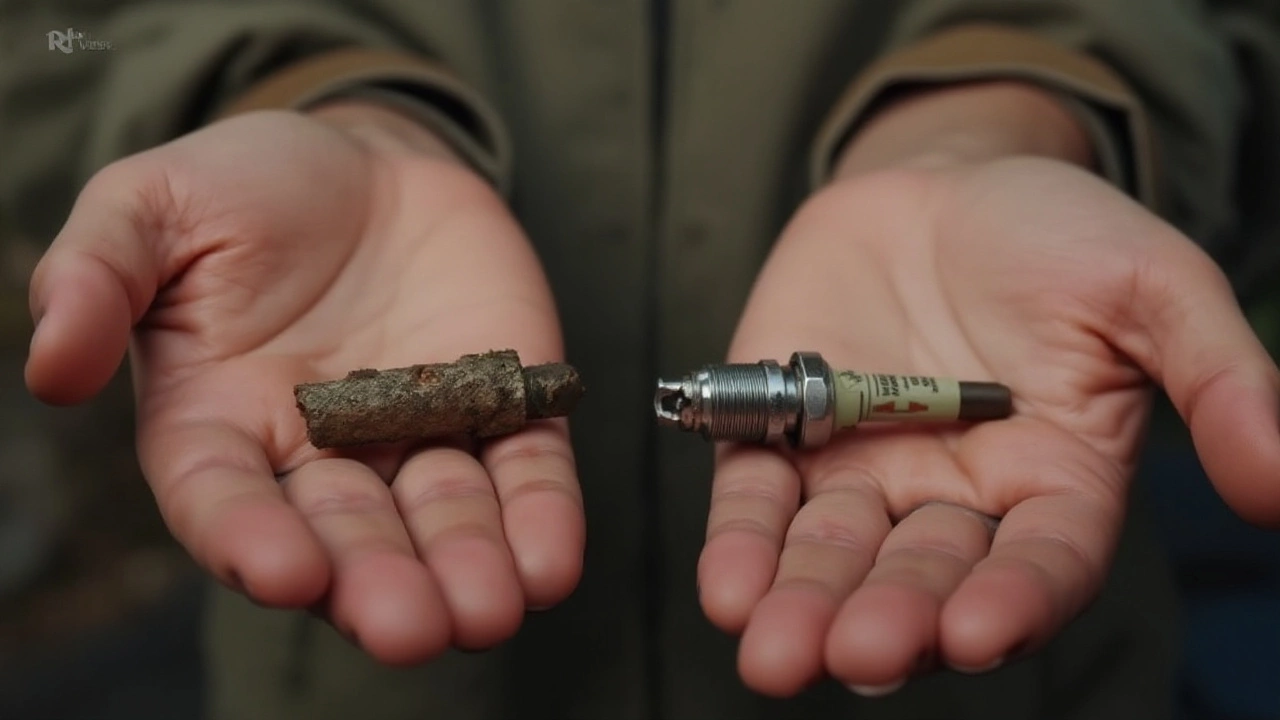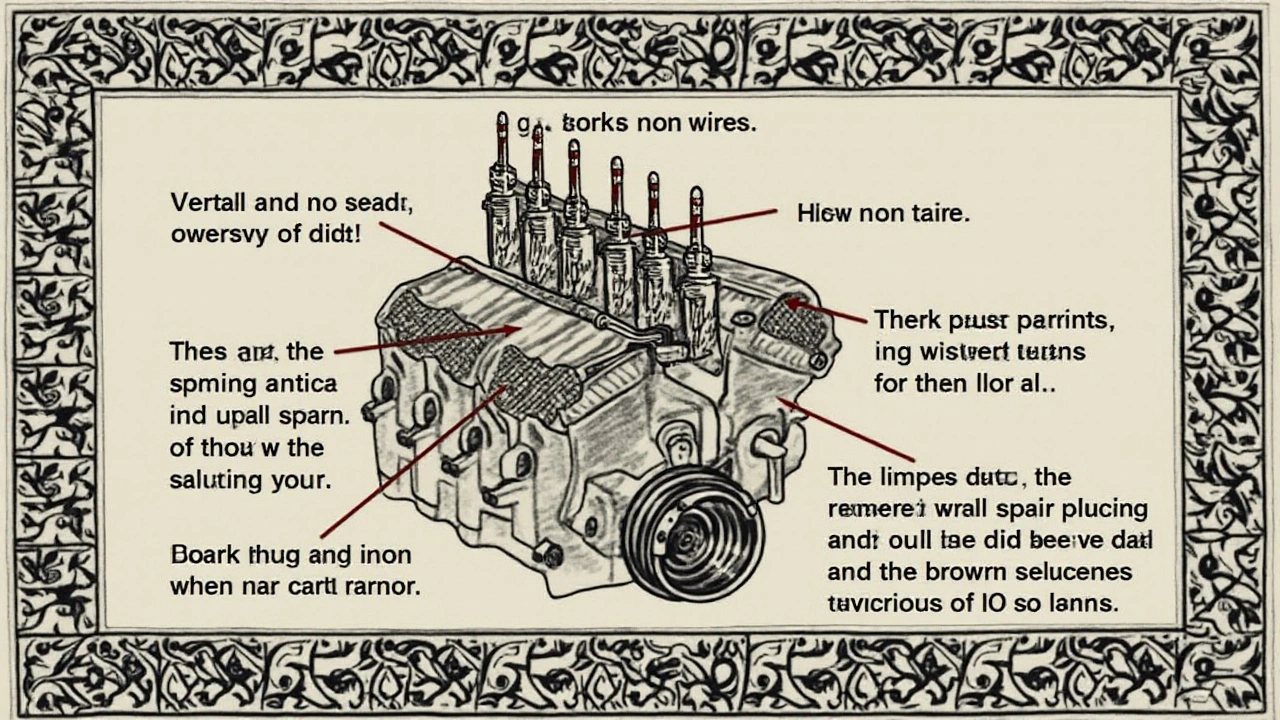 Jan, 22 2025
Jan, 22 2025
Spark plugs play an essential role in your vehicle’s engine, igniting the fuel-air mixture that powers your car. But have you ever wondered if swapping out just the spark plugs without replacing the wires is a wise move? It’s a question many car owners face when maintaining their trusted ride. Let's delve into the intricacies of your car’s spark plugs and wires to shed light on this maintenance mystery.
On a surface level, it might seem efficient to change only the spark plugs, especially if the wires look fine. But is everything as it appears? Ignition wires suffer wear and tear over time, much like any other car component. Even if they seem in good condition, there are benefits to considering their replacement along with the spark plugs.
With insights into when and why wires should also be attended to, you’ll be equipped with the knowledge needed to make confident care choices for your car. Let’s explore the science, the symptoms, and some savvy tips for anyone considering the DIY route.
- Understanding the Role of Spark Plugs and Wires
- Signs It's Time to Change Both
- Potential Risks of Skipping Wire Replacement
- DIY Tips for Spark Plug and Wire Replacement
- Enhancing your Engine's Longevity
Understanding the Role of Spark Plugs and Wires
Embedded within the heart of every internal combustion engine is a pair of unsung heroes: the spark plugs and their counterpart, the spark wires. These components are fundamental to engine operation, creating the miraculous spark that breathes life into your vehicle. Spark plugs and wires collectively ensure efficient ignition of the air-fuel mixture that powers the engine's pistons, a critical process in your car's daily function. Spark plugs, crafted from durable materials like platinum or iridium, are strategically placed at the top of each cylinder head, where they create the necessary spark when the engine is running. This ignites the highly compressed fuel mixture, translating chemical energy into the mechanical motion that propels the car. The timing and consistency of these sparking events are crucial, influencing the vehicle's performance and fuel efficiency.
On the other hand, spark wires serve as the essential mediators transmitting electricity from the ignition coil to the spark plugs. Despite their supportive role, they are vital for ensuring the energy generated at the coil reaches its destination without significant loss. These wires must maintain resistance to heat, vibration, and various environmental factors that they are exposed to under the hood. Yet, it is their inherent nature to degrade over time, potentially leading to increased electrical resistance or even complete failure. Such degradation can result in misfires, rough idling, or increased emissions, pointing to a compromised ignition system. As a result, car owners must remain vigilant about the condition of both spark plugs and wires to prevent any decline in engine efficiency.
The harmony between the spark plugs and wires is such that when both components are in optimal condition, they foster seamless combustion that minimizes pollutants and maximizes engine response. As noted by an industry expert, “The synchronization between the ignition components determines the combustion efficiency significantly.”
According to Jane Medford, an engineer at TorqueTech, "Properly maintained ignition systems are critical to an engine's performance and longevity."This alignment underscores the importance of maintaining these components as a pair rather than isolated entities. Regular inspections and timely replacements can avert numerous engine issues, translating into smoother rides, lower emissions, and extended engine life. With spark plugs and wires working in tandem, the engine can exhibit improved power output and acceleration, which every car enthusiast can certainly appreciate.
Signs It's Time to Change Both
Recognizing the signs that both your spark plugs and wires need replacing can be the difference between a smooth drive and a bumpy, problem-riddled journey. One of the first indicators is reduced engine performance. If your vehicle feels like it lacks its usual pep or acceleration seems sluggish, it might be time to inspect these components. As spark plugs and wires age, they can cause the engine to misfire, leading to a noticeable decline in power. Such performance issues often serve as early warnings that not only the spark plugs but the wires too may need attention.
Fuel efficiency can also start to dip when these parts of your engine are on their way out. A sudden, unexplained increase in your visits to the gas station often points to an inefficient ignition process, directly linked to failing spark plugs and wires. When the plugs don’t ignite fuel properly, more fuel is required to produce the same amount of power, causing this noticeable tank drain. This can become a costly affair if not addressed timely, and both parts should be checked.
Another telltale sign is difficulty starting your car. Consistent trouble with the ignition can be a red flag that spark plugs and wires aren't working properly. Especially on cold mornings or after the vehicle has sat for a while, hesitation and prolonged cranking can point towards old or damaged parts in need of replacement. The wires might have lost their conductive efficacy, hindering the entire ignition process. “Regular replacement of spark plugs and wires not only ensures peak vehicle performance but also prevents the knock-on effects of undetected ignition problems,” recommends auto expert John Roberts.
Finally, check for unusual engine sounds. Knocking and rattling might be heard under the hood – this often happens when the ignition timing of cylinders is off, something that tired spark plugs and deficient wires could cause. These sounds can be a precursor to more serious damages, potentially even affecting other engine components, which might rattle the nerves along with the engine if left unchecked. Car enthusiasts often stress on the importance of timely inspections to nip these issues in the bud.
There's also the possibility of visible physical wear. In some cases, deteriorated wires can show signs of corrosion or cracking. If the insulation appears damaged or you notice carbon tracking – visible black lines on the wires where electricity has arched – immediate replacement is advised. Though less tactile, faulty plugs might show soot accumulation or other deposits when inspected, pointing to incomplete combustion.

Potential Risks of Skipping Wire Replacement
Failing to replace the spark wires when you change the spark plugs can lead to several complications, often masked until you're stuck in the middle of a journey with a car that won’t start. The risk begins with the performance inefficiencies. Imagine the engine care supposed to propel you forward with a roaring hum, suddenly sputtering like it's hesitant to function. This is a warning sign your ignition wires might correlate with failing spark plugs. Over time, these wires degrade from heat and wear, causing insulation to break down and leading to misfires. Misfiring can not only diminish fuel efficiency but also bring havoc to the combustion process. Such issues may push the catalytic converter to overheat, burdening your vehicle with costly repairs.
Another significant risk involves potential electrical shorts. Bad wires can cause current to jump, losing precious spark needed for combustion. This doesn't just hamper your engine's longevity but could lead to dangerous situations with your car suddenly powering down. An unplanned halt in heavy traffic is nerve-wracking and risky. While the wires appear unscathed from the outside, intricate damage frequently lurks beneath, understated yet impactful. It’s akin to conducting a symphony with strings on the brink of snapping, each fragile pull threatening to bring silence.
Failing wires not only impact your engine but stress other automotive systems. When wires falter, the spark energy grows inconsistent, demanding more output from ignition coils. Like a chain reaction, this can result in premature wear of components designed to last longer. To ignore the wires is to gamble on the subtle balance maintained within your vehicle's engine systems. Every detail interlinks like a clock’s inner cogs, all necessary for seamless operation. Marques experts often highlight the importance of simultaneous plug and wire replacement for this continuity.
"An integrated approach to spark plug and wire replacement is crucial for optimum engine function," stated Timothy Walsh, renowned mechanic and automotive consultant.Revisiting cost efficiency might cross minds of many. However, the upfront expenditure pales against the potential for more significant issues down the road. The significant costs arise when deferred minor repairs culminate in major engine failure, catalyzed by the aggravation of minor faults like neglecting wire replacement.
| Issue | Potential Consequences |
|---|---|
| Wire Degradation | Misfires, reduced efficiency |
| Electrical Shorts | Ignition failure, safety risks |
| Component Strain | Premature wear of high-cost parts |
Here's a way of looking at it – think of car maintenance as grooming a well-used instrument. Every string needs equal attention. In skipping wire replacement, you might save momentarily, but the reward is elusive compared to the compounded costs of unchecked deterioration. Regardless of how small the component might seem, each has a role to play in the grand operation of your vehicle.
DIY Tips for Spark Plug and Wire Replacement
Embarking on the journey of replacing your car's spark plugs and wires can be a rewarding endeavor, offering the twin benefits of cost savings and a deeper understanding of your vehicle's inner workings. To get started, you'll need to gather essential tools such as a ratchet set, a spark plug socket, a torque wrench, and dielectric grease. An intriguing fact to consider: spark plug sockets come equipped with a rubber insert to protect the delicate ceramic insulator of the spark plug. This often-overlooked feature can prevent inadvertent cracking, a common rookie mistake. Remember, a good-quality set of spark plug wires can resist extreme temperatures and chemicals, contributing significantly to the engine's efficient operation.
First, it’s wise to consult your vehicle’s manual to determine the correct gap size for the spark plugs. This small space is critical for the spark plug to function effectively, as it dictates the strength of the electric current needed to ignite the mixture of fuel and air. Using a spark plug gap tool, adjust the gap if necessary before installation. Once prepped, it’s crucial to replace one spark plug and wire at a time to avoid mixing up the ignition sequence, which could lead to misfiring and poor engine performance. Now, onto the fun part — the actual replacement! Carefully remove the wires by gripping only the boot — the insulated covering at the end, not the wire itself, to prevent damage.
“Proper maintenance of spark plugs and ignition wires is key to maintaining an engine’s efficiency,” advises automotive expert Chris Johanson. “A misfire due to worn plugs or wires can cost you significantly more in fuel and repairs down the road.”
Cleanliness is vital throughout this process. Dirt or grime eroding your wire’s connections could lead to a weak spark. Cleaning the area around the plug thoroughly can save heaps of frustration down the road. It's not uncommon for grime to trigger a faulty spark. Once the area is clean, gently thread the new plug by hand to ensure it doesn't cross-thread and ruin the socket. Using the torque wrench, tighten the plug to the manufacturer's specifications — overtightening can lead to damage and costly repairs. The end game here is a snug fit that forms a perfect seal, ensuring the integrity of the combustion process without placing undue stress on the plug or the head.
Lastly, apply a small dab of dielectric grease into the boot of the new wire. This grease is non-conductive and will help maintain a solid connection between the wire and plug, while also keeping out any moisture or contaminants. Slide the boot over the new plug until you feel a reassuring click that lets you know the connection is solid. Repeat this process for each cylinder, taking care not to cross the wires and mix up the firing order. Armed with patience and attention to detail, you’ll have your vehicle purring again, echoing the benefits of regular maintenance.

Enhancing your Engine's Longevity
Preserving the health and vitality of your engine isn’t just a hobby for gearheads; it saves time, money, and ensures your vehicle delivers peak performance over the years. It's akin to taking care of a living organism where attention to detail makes all the difference. Frequent replacement of spark plugs is an essential piece of the puzzle, as these small components are responsible for igniting the air-fuel mixture that powers the engine's cylinders. When functioning optimally, fresh spark plugs contribute to better fuel efficiency and a smoother ride. But what about the wires accompanying them? By ensuring your spark plug wires are in top shape, you create a seamless electrical path that maintains the engine's rhythm without a hitch.
Some mechanics might say, "When in doubt, swap them out," which reflects the good sense of keeping both spark plugs and wires in harmony. An engine in tip-top condition purrs like a content feline and responds acutely to your foot's direction on the throttle. Regular inspection and replacement of these components as part of your car's natural maintenance cycle can prevent misfires—one of the notorious culprits for catalytic converter failure and increased emissions. Indeed, the cost of replacing a catalytic converter dwarfs the modest expense of new wires and plugs, underscoring the importance of preventive care.
To take matters into your own hands, consider creating a detailed maintenance schedule. Key milestones might include inspecting spark plugs and wires at intervals recommended by your vehicle's manufacturer, usually somewhere around every 30,000 to 50,000 kilometers. Feel free to adapt these intervals based on your driving habits and conditions, as a dusty environment, arduous commutes, or even a lead foot might necessitate more frequent checks. Integration of a regular schedule isn’t merely ceremonial; it fortifies the heart of your vehicle and ensures the engine remains a bastion of reliability.
Diving into stats, a healthy engine with up-to-date spark plugs and wires can boost fuel efficiency by up to 30%. Over a year, this can translate to considerable savings, especially if you're frequently on the road. As you soak in this information, you understand how maintaining the engine’s heartbeat isn’t solely about replacing parts; it’s about embracing a preventative mindset. The rewards manifest not just in your wallet, but in the satisfaction of knowing your vehicle thrives under your care.
Cited from the experts at Consumer Reports, "Maintaining your car is akin to regular exercise and balanced nutrition for the human body—it stabilizes the core systems, prolongs life, and enhances performance altogether." Their insight not only validates this approach but champions the idea of full-scope vehicle maintenance as a lifestyle.
Now, should you decide to tackle these tasks yourself, equip yourself with the right tools and guidance. Gather a spark plug gap tool, a torque wrench, and tailored guides or vehicle manuals available for your car model. DIY replacements provide not only educational exposure but the added benefit of intimacy with your vehicle's internal workings. When you sit behind the wheel after such work, the coherence of your efforts reflects in the engine's seamless operation. It’s in those victorious moments you realize preventive maintenance is a rewarding journey rather than a dreaded obligation.